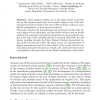Free Online Productivity Tools
i2Speak
i2Symbol
i2OCR
iTex2Img
iWeb2Print
iWeb2Shot
i2Type
iPdf2Split
iPdf2Merge
i2Bopomofo
i2Arabic
i2Style
i2Image
i2PDF
iLatex2Rtf
Sci2ools
MICCAI
1998
Springer
1998
Springer
A Biomechanical Model of the Human Tongue and Its Clinical Implications
Many surgical technics act on the upper airway in general, and on the tongue in particular. For example, tongue is one of the anatomical structures involved in the case of Pierre Robin syndrome, mandibular prognathism, or sleep apnoea syndrome. This paper presents the biomechanical and dynamical model of the human tongue we have developed, and the method we have used to fit this model to the anatomical and physical properties of a given patient's tongue. Each step of the modeling process is precisely described: the soft tissues modeling through the Finite Element Method (geometrical design of the FE structure within the upper airway and representation of lingual musculature), and the motor control of the model with the corresponding dynamical simulations. Finally, the syndromes listed above are presented, with some focus on the clinical implications of the model.
| Added | 06 Aug 2010 |
| Updated | 06 Aug 2010 |
| Type | Conference |
| Year | 1998 |
| Where | MICCAI |
| Authors | Yohan Payan, Georges Bettega, Bernard Raphaël |
Comments (0)

